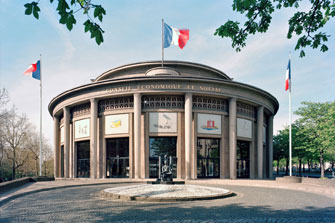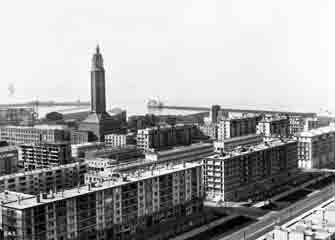Concrete Beauty in
Majestic Structures

The Palais d’Iéna in Paris. Photo © Benoît Fougeirol
Exhibitions on architecture are always problematic. How can the scope of an architect’s work be effectively communicated to nonprofessionals, who don’t necessarily know how to read plans, without being dry and technical? Scale models and photos can fill in some of the gaps but are not ideal.
A new exhibition in Paris solves this problem neatly: it is held in a notable building designed by the architect himself, one that is not usually open to the public, giving us a chance to admire its interior. “Auguste Perret: Eight Masterpieces!/?” (that annoying question mark in the title makes it seem as if the curators doubt whether they really are masterpieces) is being shown in the lobby of the Palais d’Iéna (pictured above), with its extravagant spaces and high ceilings framing a majestic interior staircase.
Perret (1874-1954) is probably best known for the reconstruction of the port city of Le Havre following its extensive destruction by bombing during World War II. His work there was acknowledged by Unesco in 2005, when it was declared a World Heritage Site for its “unity and integrity” and the way it “combines a reflection of the earlier pattern of the town

An aerial view of Le Havre, looking toward Perret’s Eglise Saint Joseph. © CNAM/SIAF/CAPA, Archives d’architecture du XXe siècle/Auguste Perret/UFSE/SAIF
and its extant historic structures with the new ideas of town planning and construction technology.”
Unesco also cited the “innovative exploitation of the potential of concrete,” which was Perret’s main claim to fame. The son of a building contractor who worked with his brothers Gustave and Claude, he was an adept at the use of reinforced concrete. While he based his designs on historical forms, he took advantage of the intrinsic properties of concrete to create handsome effects and contrasting textures without concealing the underlying structure of the building, as so many of his colleagues continued to do at the turn of the 20th century. Witness the Grand Palais in Paris, for example, whose modern metal structure was hidden behind Beaux-Arts decorative flourishes.
The exhibition brings each of the eight projects to life with the usual plans, photographs and models (large and detailed enough to be truly informative), as well as furniture designed by Perret himself, including a wonderful pivoting desk. There are also quirky exhibits like a boat made in 1849 of reinforced concrete that actually floats. The main attraction, however, is the building itself. Since the exhibition is held in the lobby, visitors get a good impression of its impressive spaces. I wandered into the conference room to admire its beautiful domed ceiling and took a walk up the grand staircase, examining the variegated textures of the walls along the way.
The exhibition’s sleek presentation was designed by OMA, the firm of one of today’s hottest architects, Rem Koolhaas.
Visitors who want to know more will be inspired to hop on a train to Le Havre or at least have a look at an apartment building designed by Perret at 25 bis, rue Franklin in Paris’s 16th arrondissement, where the offices of his firm were located. He also created the structure for the city’s Théâtre des Champs Elysées, but unlike his other works, the facade of this building – considered too plain when it was built in 1913 – was covered with decorative bas-reliefs by the sculptor Antoine Bourdelle.
Perret’s name does not pack the same punch as that of his one-time employee Le Corbusier, but this exhibition is a welcome reminder of the work of an architect who brought out the beauty of a material most think of as simply utilitarian or even ugly.
Palais d’Iéna: 9, place d’Iéna, 75016 Paris. Métro: Iéna. Open daily, 11am-6pm. Admission: free. Through February 19, 2014. www.expositionperret.fr
Click here to read all of this week’s new articles on the Paris Update home page.
Reader Michael Barker writes: “Also one might add: August Perret’s 25 bis rue Franklin of 1903 was clearly, long before the 1925 Exposition Universelle, the precursor of Art Deco architecture and innovative in breaking up the conventional street line to bring light into its interior. His later offices were not far away at 51 rue Raynouard of 1932.
“He designed the world’s very first Modern church: Notre Dame de Raincy of 1922, completed in some 14 months – the ‘Sainte Chapelle’ of modernité – with an astonishing programme of vivid stained glass – easily visited on the RER plus a 15 minutes walk.
“The Théâtre des Champs-Elysées was also modern before its time (late Art Nouveau was still being built in Paris, albeit in its death throes – look at 30 avenue Marceau of 1913-16, extraordianary though it is). The use of marble facing for the theater was required by his client for prestige (though the expense ruined him). The sculptural decoration was by Antoine Bourdelle (avant-garde indeed) and the murals inside by Maurice Denis (whose studio he later built at Denis’s home Le Prieuré at St. Germain-en-Laye – a wonderful place to visit), both great chums of Perret. The elegant wrought-iron main staircase within is arguably proto-Deco. Perret was otherwise rather against decoration. He built modernist houses in Paris for Georges Braque, the sculptress Chana Orloff and the sculptress Dora Gordine.
“Le Corbusier gets all the adulation, but all his roofs leaked and most of his buildings have needed expensive repair. Perret was a master of concrete construction, which is why his Palais d’Iéna looks so good today.”
Reader reaction: Click here to respond to this article (your response may be published on this page and is subject to editing).
Please support Paris Update by ordering books from Paris Update’s Amazon store at no extra cost. Click on your preferred Amazon location: U.K., France, U.S.
To order the catalog from this exhibition: click here: U.K., France, U.S.
More reviews of Paris art shows.
© 2014 Paris Update
Favorite